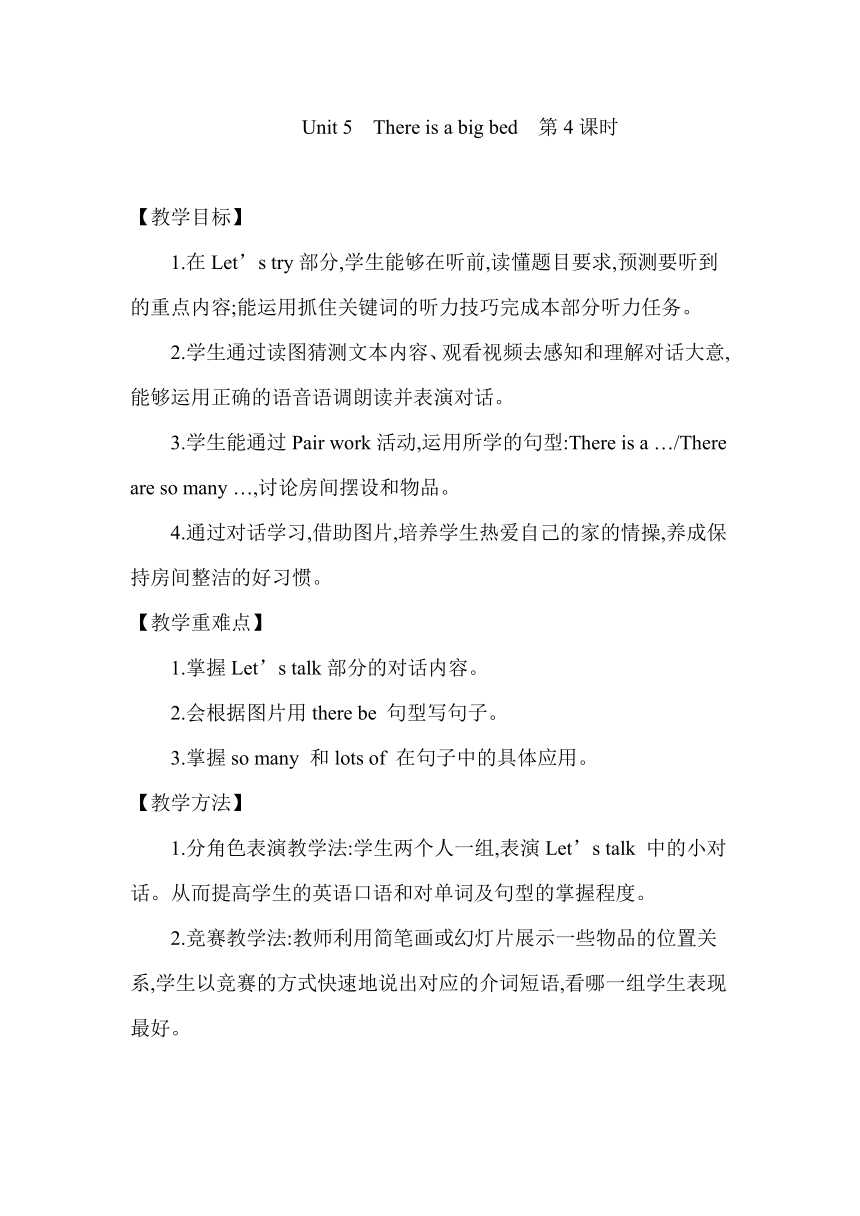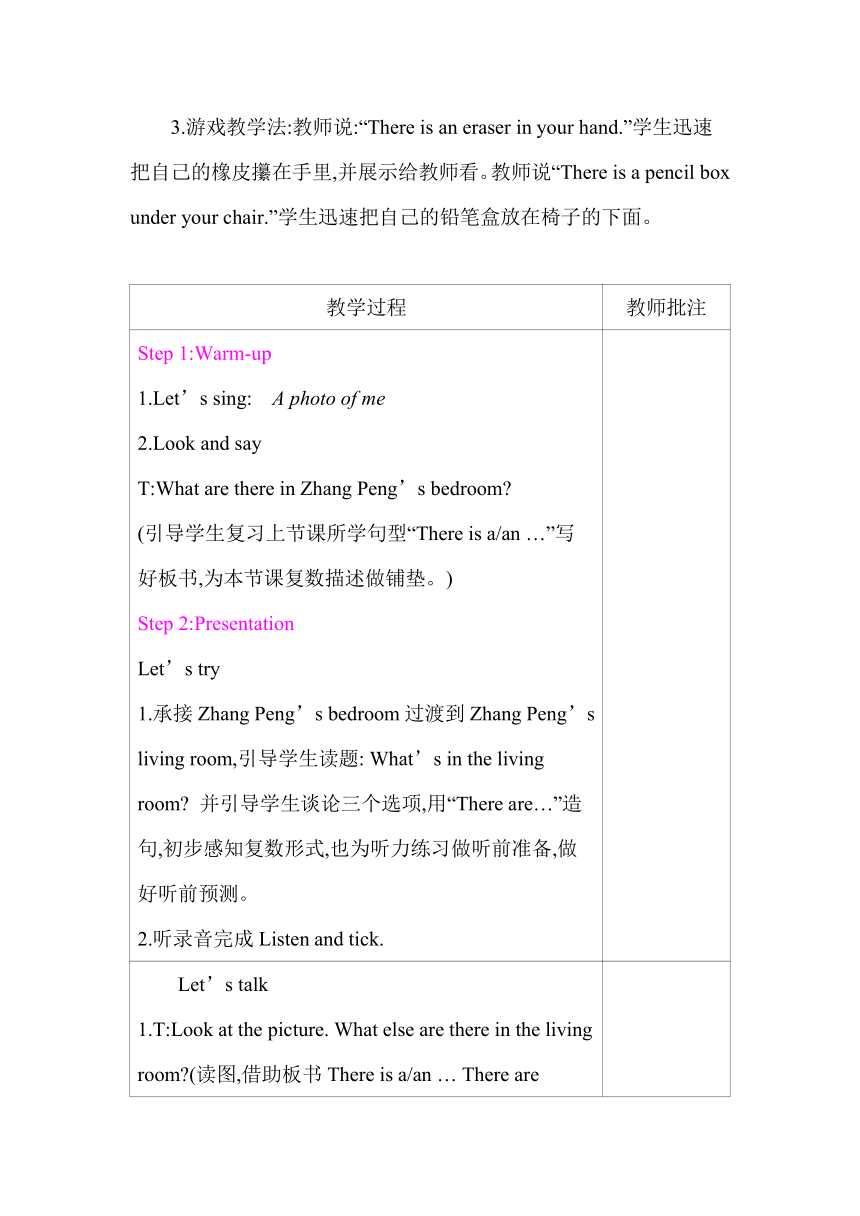Unit 5 There is a big bed Part B let's talk 教案(含反思)
文档属性
| 名称 | Unit 5 There is a big bed Part B let's talk 教案(含反思) |  | |
| 格式 | docx | ||
| 文件大小 | 17.6KB | ||
| 资源类型 | 教案 | ||
| 版本资源 | 人教版(PEP) | ||
| 科目 | 英语 | ||
| 更新时间 | 2021-09-08 09:38:47 | ||
图片预览


文档简介
Unit
5 There
is
a
big
bed
第4课时
【教学目标】
1.在Let’s
try部分,学生能够在听前,读懂题目要求,预测要听到的重点内容;能运用抓住关键词的听力技巧完成本部分听力任务。
2.学生通过读图猜测文本内容、观看视频去感知和理解对话大意,能够运用正确的语音语调朗读并表演对话。
3.学生能通过Pair
work活动,运用所学的句型:There
is
a
…/There
are
so
many
…,讨论房间摆设和物品。
4.通过对话学习,借助图片,培养学生热爱自己的家的情操,养成保持房间整洁的好习惯。
【教学重难点】
1.掌握Let’s
talk部分的对话内容。
2.会根据图片用there
be
句型写句子。
3.掌握so
many
和lots
of
在句子中的具体应用。
【教学方法】
1.分角色表演教学法:学生两个人一组,表演Let’s
talk
中的小对话。从而提高学生的英语口语和对单词及句型的掌握程度。
2.竞赛教学法:教师利用简笔画或幻灯片展示一些物品的位置关系,学生以竞赛的方式快速地说出对应的介词短语,看哪一组学生表现最好。
3.游戏教学法:教师说:“There
is
an
eraser
in
your
hand.”学生迅速把自己的橡皮攥在手里,并展示给教师看。教师说“There
is
a
pencil
box
under
your
chair.”学生迅速把自己的铅笔盒放在椅子的下面。
教学过程
教师批注
Step
1:Warm-up
1.Let’s
sing: A
photo
of
me
2.Look
and
say
T:What
are
there
in
Zhang
Peng’s
bedroom?
(引导学生复习上节课所学句型“There
is
a/an
…”写好板书,为本节课复数描述做铺垫。)
Step
2:Presentation
Let’s
try
1.承接Zhang
Peng’s
bedroom过渡到Zhang
Peng’s
living
room,引导学生读题:
What’s
in
the
living
room?
并引导学生谈论三个选项,用“There
are…”造句,初步感知复数形式,也为听力练习做听前准备,做好听前预测。
2.听录音完成Listen
and
tick.
Let’s
talk
1.T:Look
at
the
picture.
What
else
are
there
in
the
living
room?(读图,借助板书There
is
a/an
…
There
are
some…描述)
2.Watch,tick
and
check.
让学生在原文找到原句,教师板书,学生填空,
提示注意名词的复数形式。
There
are
so
many
pictures
here.There
are
so
many
plants
here.
pair
work
3.Listen,
repeat
and
underline
the
answer.
(1)Who
can
draw
very
well?
(2)Whose
plants
are
these?
(3)Where
are
the
plants?
在原文中找到相关句子:
(1)My
father
draws
very
well.
(2)They’re
my
grandma’s
plants.
(3)My
grandparents
have
a
garden
in
front
of
their
house.(解决难点have
a
garden
in
front
of)。
4.教师播放完整对话的动画,学生跟读对话。教师提醒学生注意语音、语调、意群及感情。
Step
3:Practice
1.Read
the
talk
with
your
partner.分角色扮演。
2.Let’s
dub.
Step
4:Consolidation
and
extension
1.听句子画一画
There
is
a
desk
in
the
room.There
is
a
plant
on
the
desk.There
is
a
TV
on
the
desk.There
are
two…
然后,学生展示他们的画。
2.晒晒你的房间
你的房间里有什么?用自己准备的单词卡片把它们展示出来。然后同桌之间交换一下,并根据对方的房间创编一个小对话。
3.根据我们的周围环境,四个人一组创编对话,要用上there
be
句型。
Step
5:Homework
1.让学生听Let’s
talk部分的录音,然后读给朋友或家长听。
2.用英语向爸爸妈妈介绍自己理想中的房间。
教学反思
[成功之处] 本课时创设的情景是观察图片,通过观察图片,引出句型:Where
are
the…?
What
is
in
the
living
room?然后让学生带着问题看视频,整体感知对话内容,最后通过游戏来巩固所学内容。这些活动给学生提供了一个有趣、轻松、活泼、充满竞争的氛围,让学生在具体情境中体会句子的意义和用法,收到了较为理想的效果。
[不足之处] 部分学生对there
is
和
there
are的具体使用情况比较模糊,教师还需要提供、设计更多的活动进行操练和巩固。
[再教设计] 通过让学生观察教师提供的或者课本中房间的图片,让学生说出所观察到的物品,并用there
be句型表达出来形成一个完整的句子。这样,学生脑海中对there
be句型的构成方式就有了更深的印象。
5 There
is
a
big
bed
第4课时
【教学目标】
1.在Let’s
try部分,学生能够在听前,读懂题目要求,预测要听到的重点内容;能运用抓住关键词的听力技巧完成本部分听力任务。
2.学生通过读图猜测文本内容、观看视频去感知和理解对话大意,能够运用正确的语音语调朗读并表演对话。
3.学生能通过Pair
work活动,运用所学的句型:There
is
a
…/There
are
so
many
…,讨论房间摆设和物品。
4.通过对话学习,借助图片,培养学生热爱自己的家的情操,养成保持房间整洁的好习惯。
【教学重难点】
1.掌握Let’s
talk部分的对话内容。
2.会根据图片用there
be
句型写句子。
3.掌握so
many
和lots
of
在句子中的具体应用。
【教学方法】
1.分角色表演教学法:学生两个人一组,表演Let’s
talk
中的小对话。从而提高学生的英语口语和对单词及句型的掌握程度。
2.竞赛教学法:教师利用简笔画或幻灯片展示一些物品的位置关系,学生以竞赛的方式快速地说出对应的介词短语,看哪一组学生表现最好。
3.游戏教学法:教师说:“There
is
an
eraser
in
your
hand.”学生迅速把自己的橡皮攥在手里,并展示给教师看。教师说“There
is
a
pencil
box
under
your
chair.”学生迅速把自己的铅笔盒放在椅子的下面。
教学过程
教师批注
Step
1:Warm-up
1.Let’s
sing: A
photo
of
me
2.Look
and
say
T:What
are
there
in
Zhang
Peng’s
bedroom?
(引导学生复习上节课所学句型“There
is
a/an
…”写好板书,为本节课复数描述做铺垫。)
Step
2:Presentation
Let’s
try
1.承接Zhang
Peng’s
bedroom过渡到Zhang
Peng’s
living
room,引导学生读题:
What’s
in
the
living
room?
并引导学生谈论三个选项,用“There
are…”造句,初步感知复数形式,也为听力练习做听前准备,做好听前预测。
2.听录音完成Listen
and
tick.
Let’s
talk
1.T:Look
at
the
picture.
What
else
are
there
in
the
living
room?(读图,借助板书There
is
a/an
…
There
are
some…描述)
2.Watch,tick
and
check.
让学生在原文找到原句,教师板书,学生填空,
提示注意名词的复数形式。
There
are
so
many
pictures
here.There
are
so
many
plants
here.
pair
work
3.Listen,
repeat
and
underline
the
answer.
(1)Who
can
draw
very
well?
(2)Whose
plants
are
these?
(3)Where
are
the
plants?
在原文中找到相关句子:
(1)My
father
draws
very
well.
(2)They’re
my
grandma’s
plants.
(3)My
grandparents
have
a
garden
in
front
of
their
house.(解决难点have
a
garden
in
front
of)。
4.教师播放完整对话的动画,学生跟读对话。教师提醒学生注意语音、语调、意群及感情。
Step
3:Practice
1.Read
the
talk
with
your
partner.分角色扮演。
2.Let’s
dub.
Step
4:Consolidation
and
extension
1.听句子画一画
There
is
a
desk
in
the
room.There
is
a
plant
on
the
desk.There
is
a
TV
on
the
desk.There
are
two…
然后,学生展示他们的画。
2.晒晒你的房间
你的房间里有什么?用自己准备的单词卡片把它们展示出来。然后同桌之间交换一下,并根据对方的房间创编一个小对话。
3.根据我们的周围环境,四个人一组创编对话,要用上there
be
句型。
Step
5:Homework
1.让学生听Let’s
talk部分的录音,然后读给朋友或家长听。
2.用英语向爸爸妈妈介绍自己理想中的房间。
教学反思
[成功之处] 本课时创设的情景是观察图片,通过观察图片,引出句型:Where
are
the…?
What
is
in
the
living
room?然后让学生带着问题看视频,整体感知对话内容,最后通过游戏来巩固所学内容。这些活动给学生提供了一个有趣、轻松、活泼、充满竞争的氛围,让学生在具体情境中体会句子的意义和用法,收到了较为理想的效果。
[不足之处] 部分学生对there
is
和
there
are的具体使用情况比较模糊,教师还需要提供、设计更多的活动进行操练和巩固。
[再教设计] 通过让学生观察教师提供的或者课本中房间的图片,让学生说出所观察到的物品,并用there
be句型表达出来形成一个完整的句子。这样,学生脑海中对there
be句型的构成方式就有了更深的印象。
